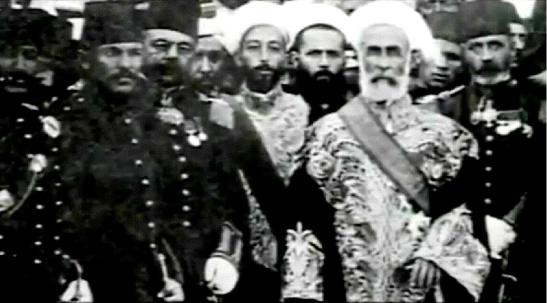
His Exalted Highness Sayyid Hussein bin Ali, GCB, the Sharif of Mecca, and Emir of Mecca (1908-1917), King of the Hejaz, and King of the Arabs, Caliph of the Prophet Muhammad (sallallahu alaihi wa sallam).
The Great Arab Revolt
Much of the trauma and dislocation suffered by the peoples of the Middle East during the 20th century can be traced to the events surrounding World War I. During the conflict, the Ottoman Empire sided with the Central Powers against the Allies. Seeing an opportunity to liberate Arab lands from Turkish oppression, and trusting the honor of British officials who promised their support for a unified kingdom for the Arab lands, Sharif Hussein bin Ali, Emir of Mecca and King of the Arabs (and great grandfather of King Hussein), launched the Great Arab Revolt. After the conclusion of the war, however, the victors reneged on their promises to the Arabs, carving from the dismembered Ottoman lands a patchwork system of mandates and protectorates. While the colonial powers denied the Arabs their promised single unified Arab state, it is nevertheless testimony to the effectiveness of the Great Arab Revolt that the Hashemite family was able to secure Arab rule over Transjordan, Iraq and Arabia.
In order to discern the motives of the Hashemites in undertaking the revolt, one must understand the policies undertaken by the Ottoman Empire in the years leading up to World War I. Following the Young Turk coup of 1908, the Ottomans abandoned their pluralistic and pan-Islamic policies, instead pursuing a policy of secular Turkish nationalism. The formerly cosmopolitan and tolerant Ottoman Empire began overtly discriminating against its non-Turkish inhabitants. Arabs in particular were faced with political, cultural and linguistic persecution. During this time, Arab nationalist groups in Syria, Iraq and Arabia began to rally behind the Hashemite banner of Abdullah and Faisal, sons of Sharif Hussein bin Ali, King of the Arabs.
When the Ottomans entered World War I on the side of the Central Powers in 1914, they upheld the ban on the official use of the Arabic language and its teaching in schools, while arresting many Arab nationalist figures in Damascus and Beirut. Arabs were further threatened by the construction of the Hijaz Railway, connecting Damascus and Mecca, which promised to facilitate the mobility of Turkish troops into the Arab heartland.
Consequently, in June 1916, as head of the Arab nationalists and in alliance with Britain and France, Sharif Hussein initiated the Great Arab Revolt against Ottoman rule. His sons, the emirs Abdullah and Faisal, led the Arab forces, with Emir Faisal’s forces liberating Damascus from Ottoman rule in 1918. At the end of the war, Arab forces controlled all of modern Jordan, most of the Arabian peninsula and much of southern Syria.
Sharif Hussein’s objective in undertaking the Great Arab Revolt was to establish a single independent and unified Arab state stretching from Aleppo (Syria) to Aden (Yemen), based on the ancient traditions and culture of the Arab people, the upholding of Islamic ideals and the full protection and inclusion of ethnic and religious minorities. Arab nationalists in the Fertile Crescent and the Arabian Peninsula found in the Hashemite commanders of the Great Arab Revolt the leadership that could realize their aspirations, and thus coalesced around them. [http://www.kinghussein.gov.jo/his_arabrevolt.html]
Sharifian Caliphate
The Sharifian Caliphate is the term used to describe the unsuccessful attempts at the beginning of the 20th century to establish an Arab caliphate headed by the Sharifs of Mecca in replacement of the Ottoman Caliphate. The idea had been floating around since at least the 15th century. It started to gain importance towards the end of the 19th century due to the decline of the Ottoman Empire, which was heavily defeated in the Russo-Turkish War of 1877–1878.
The Ottoman sultanate was abolished on 1 November 1922, in the midst of the Turkish War of Independence. However, the office of caliph was retained for an additional 16 months, during which it was held by Abdülmecid II. The latter served as caliph under the patronage of the newly founded Turkish Republic until 3 March 1924, when the Grand National Assembly of Turkey formally abolished the caliphate. Hussein bin Ali, Sharif of Mecca, seized the opportunity of the vacancy of the caliphate and proclaimed himself caliph. Hussein based his claim on his prophetic ancestry (he descended from Muhammad’s grandson al-Hasan ibn ‘Ali of the Banu Hashim clan of the tribe of Quraysh) and his control of Islam’s two holiest mosques: the Masjid al-Haram and the Masjid al-Nabawi, collectively known as the Haramayn. Possession of the Haramayn was an indispensable condition for any caliph. According to The Times, Mehmed VI (the last Ottoman sultan and penultimate Ottoman caliph) sent a telegraph of support to Hussein when he proclaimed himself caliph. Nevertheless, King Hussein’s caliphate was defeated when the Hashemite family had to flee the Hejaz region upon its capture in 1924–25 by the Wahhabi Najdi-Ikhwan forces of Ibn Saud, the founder of today’s Saudi Arabia.

